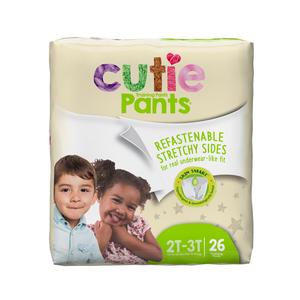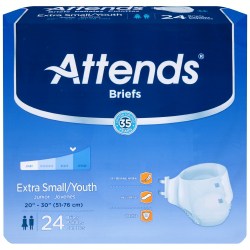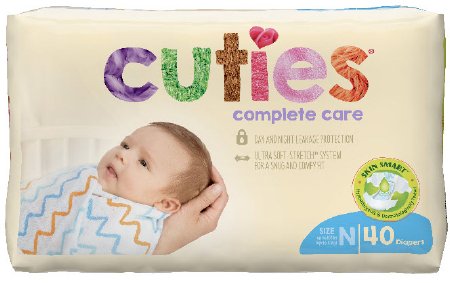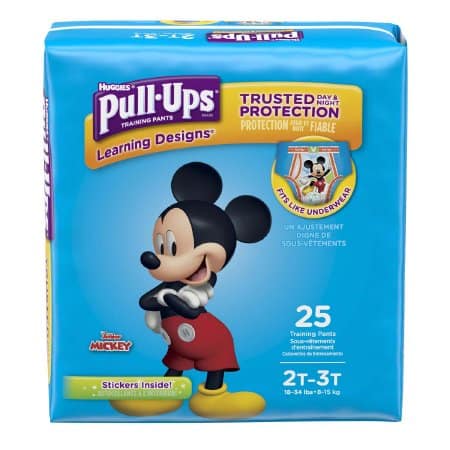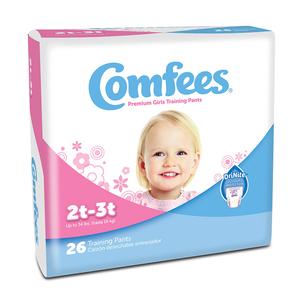Children with special needs often experience incontinence due to physical, mental, or emotional challenges related to their disability. Contrary to popular belief, incontinence is not limited to an issue for the elderly. The older community has a wide variety of products, support, and available treatment options. For children with special needs, entirely different incontinence solutions are needed to address their specific needs.
Common Conditions Related to Incontinence and Children with Special Needs
Incontinence can be very different for each child with special needs. Some children experience incontinence that extends past their toddler stage, and others may have incontinence that extends into their adult years.
The most common medical conditions related to incontinence in children with special needs are:
Autism
Autism spectrum disorder (ASD) is a developmental disorder that affects communication and social interaction in children. There are a wide variety of symptoms of autism, which can range from mild to severe.
Some common symptoms may include:
- Disinterest in playing or talking to others
- Avoiding eye contact or physical contact
- Preferring always to be left alone
- Delayed speech and language skills
- Repetition of words or phrases
- Inability to stay on topic when answering questions
- Fixations on particular objects or activities
- Aggressive behavior toward themselves and others
Autism-related incontinence is typically due to the challenges children with special needs face with any of the above behavioral, cognitive, or functional problems. Simply communicating that they need to empty their bladder or not being aware that they need to urinate are common issues in children with autism.
Multiple Sclerosis
Multiple sclerosis (MS) is an autoimmune disease that can come on at any point in a person’s life. MS is a chronic condition that affects the central nervous system. This debilitating disease can cause problems with muscle control and other daily bodily functions such as bladder and bowel control. Children with special needs such as MS can experience incontinence due to the disruption of the brain’s nerve signals and the bladder or bowels.
Spinal Cord Injury or Spina Bifida
If a child has a spinal cord injury or spina bifida, they will have damage to their spinal cord, which can cause paralysis and disrupt nerve communication to certain areas of the body depending on the level of severity of spinal damage.
When these nerves are damaged, the signals that are supposed to control our ability to empty our bladder and bowels are not present. Children with special needs such as a spinal cord injury may have a complete loss of bladder and bowel control, or they may have a partial loss and may choose self-catheterization as an option to empty their bladder.

Cerebral Palsy
Cerebral Palsy is damage to a child’s brain as it develops, whether in the womb or after birth. This damage to the brain causes a lack of muscle coordination, muscle control, posture, and reflexes. Because the abdominal muscles are affected in Cerebral Palsy, bladder and bowel control are compromised. These muscles may involuntarily contract and lead to stress incontinence, leakage due to the inability to control the bladder muscles.
Children with special needs such as Cerebral Palsy may also deal with issues such as overactive bladder (failure to empty the bladder fully), overflow incontinence (leakage due to the bladder not fully emptying), or urge incontinence (bladder spasms causing the bladder to shrink before reaching the restroom).
Down Syndrome
Down syndrome is a genetic disorder caused by the partial or full copy of chromosome 21 due to abnormal cell divisions when a child is developing in the womb. Children with special needs such as Down syndrome may have issues such as impaired cognitive ability, developmental delays, and gastrointestinal and urinary complications.
Because of the cognitive impairments children with Down syndrome experience, acquiring bathroom habits takes longer. Children with Down Syndrome tend to have weaker bladder muscles and cannot contract their bladder to release urine, leading to urinary retention and the risk of bladder infections.

Common Types of Incontinence in Children with Special Needs
Nocturnal enuresis
Nocturnal enuresis, also known as bedwetting, occurs when a child can’t control urination at night while in bed.
Daytime urinary incontinence
When a child with special needs loses bladder control during the day, they have daytime urinary incontinence. This type of incontinence in children with special needs can be caused by an overactive bladder, weak bladder muscles, or any nervous system defect.
Fecal incontinence
A child with special needs due to a spinal cord injury is prone to having accidental bowel movements due to the interruption to the communication between the spinal cord’s nerves and the bowel. The brain cannot control the muscles that coordinate the bowel function resulting in fecal incontinence.
For even more detailed information about fecal incontinence, visit our Fecal Incontinence Pads page.
Lower urinary tract symptoms
When there is a lack of coordination between the bladder muscles and the urinary tract, the bladder will not effectively empty. There are many lower urinary tract symptoms in children with special needs, such as:
- Urinary incontinence – involuntarily leaking varying amounts of urine when pressure is exerted on the bladder when coughing, sneezing, lifting objects, or exercising
- Frequency – urinating tiny amounts multiple times throughout the day
- Infrequency – not going to the bathroom for many hours
- Urge incontinence – the bladder muscles contract when they shouldn’t, causing a sudden urge to urinate
- Incomplete emptying – the bladder muscles are not able to contract properly to empty urine from the bladder
- Urinary tract infections (UTIs) – incomplete emptying of the bladder leads to stagnation of urine that can lead to an infection
Ways to Manage Incontinence in Children with Special Needs
When helping a child with special needs manage their incontinence, it is essential to be understanding and supportive. The National Association for Continence (NAFC) has come up with an approach for caregivers of children with special needs that have incontinence more tolerable and contribute to improvement opportunities. It is referred to as ‘The 5 Ps’.
The 5 Ps
- Patience – Setbacks may happen, and it is essential not to place blame on them. Maintaining a positive outlook and a good sense of humor can go a long way.
- Persistence – Keeping reminding yourself that progress overcoming or managing incontinence in a child with special needs will take time. Try setting realistic goals, and don’t give up. Keep up with patience and a positive outlook.
- Planning – Incontinence episodes usually come as surprises. Planning a routine and sticking to it can help keep everyone on a schedule. If there is a shared responsibility with the child with special needs, communication planning is vital. Make sure everyone involved has the information and incontinence supplies needed to act on it appropriately.
- Practice – Keep trying and seek out different treatment options to see if something else might work better. Use your resources, such as your family doctor or family and friends, who might recommend specific programs or products that might produce better results for your child with special needs.
- Progress is Possible – Remember that you are not alone. There are so many families of children with special needs that have overcome the stigma that incontinence is unconquerable. There are many strategies, products, and treatments to try to make your child with special needs and your life a little easier and more comfortable. Don’t give up!

Products That Can Help Manage Incontinence in Children with Special Needs
Incontinence management for children with special needs can be overwhelming at the time. However, Personally Delivered offers a wide variety of incontinence products for children that can help make it easier and your child more comfortable. Children with special needs are all different, and one size or type of incontinence product for children does not fit all.
Baby Diapers
Baby diapers are designed to move with the baby to ensure a comfortable, snug, and secure fit. Typically, baby diapers are hypoallergenic to promote healthy skin and lock away wetness for up to twelve hours. Baby diapers are available in a variety of absorbencies for both day and overnight protection.
Training Pants
Training pants are an incontinence product for children that are less bulky than the baby diaper and are designed to fit more like regular underwear. The sides of training pants open for easy adjustment, and the pull-up style makes them a comfortable option. Many training pants feature a wetness indicator that causes a design to fade away, letting you know when the training pant needs to be changed.
Youth Briefs and Protective Underwear
As a child with special needs gets a little older, they will transition into youth briefs and protective underwear as incontinence products for children. The youth briefs and diapers feature the tear-away sides for easy adjustment and changing and the protective underwear pull-on for a snug, comfortable fit. Youth briefs and protective underwear are available in various sizes and absorbencies for daytime and overnight protection.
Adult Incontinence Products
 Larger children with special needs can also wear other types of adult incontinence products.
Larger children with special needs can also wear other types of adult incontinence products.
- Protective Underwear – Just like the youth briefs and protective underwear, children with special needs larger in size can wear these one-piece pull-ups for protection both day and night.
- Adult Diapers and Briefs – For a more secure and absorbent option, adult diapers are available. Just like baby diapers, adult diapers feature re-fastenable tabs for easy adjustment.
- Booster Pads – Add a booster pad to any disposable adult diaper, brief, or protective underwear for increased absorbency. Booster pads can extend the wear-time of a primary incontinence undergarment.
- Bladder Control Pads – For light to heavy absorbency, bladder control pads protect against leakage and are worn inside regular underwear. The difference between a bladder pad and a booster pad is that fluids are not meant to flow through the bladder pad and into the primary undergarment like booster pads are made to do.
Remember that there may be setbacks when trying to manage incontinence in a child with special needs. Try to implement The 5 Ps in the process and celebrate small accomplishments. If you have any questions about the incontinence products we offer for babies, youth, or adults, our Product Experts are just a phone call away and ready to assist.


